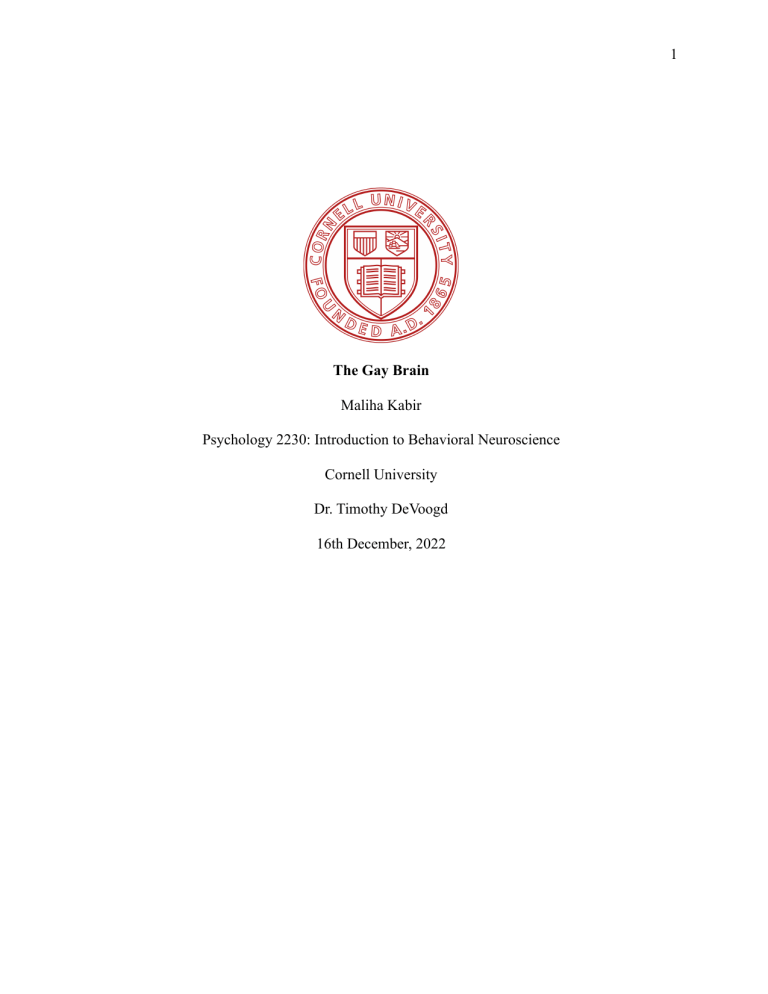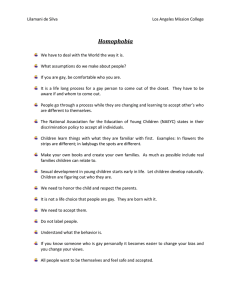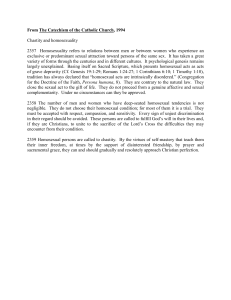
1 The Gay Brain Maliha Kabir Psychology 2230: Introduction to Behavioral Neuroscience Cornell University Dr. Timothy DeVoogd 16th December, 2022 2 ‘Being Gay is a choice’, was the thing I used to believe in before knowing about sexual orientation in this course. Growing up in a conservative society, I saw heterosexual relationships around me throughout my whole life and also on television. When I got to know about same-sex relationships I thought that people choose to be gay as they feel attraction towards the same gender and it is a lifestyle choice. However, the question that used to always roam around in my mind is how the law of attraction and the perception of sexual pleasure differs among heterosexual and homosexual people and if it is somehow related to hormones or brain structure. Also if being gay is not natural or a disorder as some people claim it is. I found the answer to my questions in this course and I finally got to know that the sexual orientation of a person is related to neurobiology. Homosexual behaviors were seen among animals like mountain sheep, dolphins, swans, and gulls (Bagemihl, 2000). The most interesting fact was that anthropoid animals with complex brain systems such as monkeys and apes tend to display homosexual behavior more than other animals (Pfau et al., 2019). It suggests that their higher brain complexity has a likelihood to increase homosexual behavior. Moreover, in another interesting research, it was found that mountain rams mounted with the male rams and refused to mount the female rams. Growing evidence suggests that "straight" and "gay" rams have a distinct preoptic area (POA), which is believed to be shaped by testosterone acting on the brain via neuronal steroid receptors during fetal development (Roselli, 2020). This evidence rules out the fact that being gay is not natural as homosexuality can be often seen in nature. POA of humans got examined by Simon LeVay in people after death and discovered a nucleus known as INAH-3. Similar to where the SDN-POA is located in rats' hypothalamus, these nuclei are present in humans (LeVay, 2017). Men's INAH-3 is larger than women's 3 INAH-3, and straight men's INAH-3 is larger than homosexual men's INAH-3. Even though the majority of the homosexual males in this study had passed away from AIDS, it should be noted that heterosexual men who had passed away from the disease still had a greater INAH3, proving that the disparities between straight and gay men are not caused by the disease. Also, in another study, it was found that prenatal exposure to androgen enhances a girl's chance of becoming homosexual (Williams et al., 2000). These studies clear out the fact that homosexuality is not a disorder as the brain is inextricably related to being gay. My doubts about how homosexuality is connected to the brain and not a sickness or anything unnatural has been answered by all this study and data. Based on societal influence and brain anatomy, a person can be gay in the same way that they can be heterosexual. Due to the removal of the shame associated with being homosexual, and the realization that being gay is not a choice, this issue, in particular, appealed to me. 4 References Bagemihl, B. (2000). Biological Exuberance: Animal Homosexuality and Natural Diversity (Stonewall Inn Editions (Paperback)) (1st ed.). Stonewall Inn Editions. LeVay, S. (2017). Gay, Straight, and the Reason why: The Science of Sexual Orientation. Oxford University Press. Pfau, D., Jordan, C. L., & Breedlove, S. M. (2019). The De-Scent of Sexuality: Did Loss of a Pheromone Signaling Protein Permit the Evolution of Same-Sex Sexual Behavior in Primates? Archives of Sexual Behavior, 50(6), 2267–2276. https://doi.org/10.1007/s10508-018-1377-2 Roselli, C. E. (2020). Programmed for Preference: The Biology of Same-Sex Attraction in Rams. Neuroscience &Amp; Biobehavioral Reviews, 114, 12–15. https://doi.org/10.1016/j.neubiorev.2020.03.032 Williams, T. J., Pepitone, M. E., Christensen, S. E., Cooke, B. M., Huberman, A. D., Breedlove, N. J., Breedlove, T. J., Jordan, C. L., & Breedlove, S. M. (2000). Finger-length ratios and sexual orientation. Nature, 404(6777), 455–456. https://doi.org/10.1038/35006555


